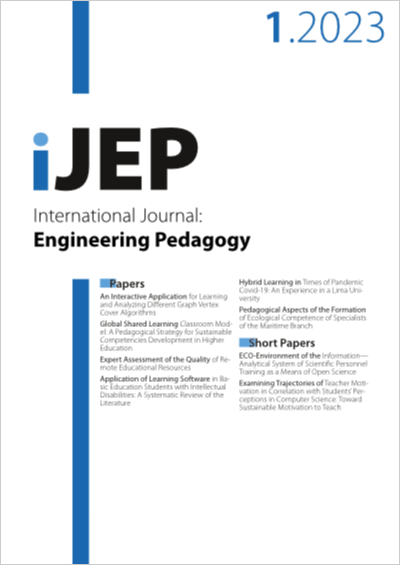Hybrid Learning in Times of Pandemic Covid-19: An Experience in a Lima University
DOI:
https://doi.org/10.3991/ijep.v13i1.36393Keywords:
hybrid learning, teaching strategies, teaching resources, evaluation system, tutoring, hybrid modality questionnaire, Covid-19 pandemicAbstract
Hybrid learning became more important in the context of the Covid-19 pandemic. In this sense, the University of Sciences and Humanities implemented adequate strategies to guarantee the continuity of the teaching and learning process. At the beginning, the virtual modality was chosen in its entirety and then moved to a hybrid modality; however, teachers were not trained; students had problems of connectivity and access to technological resources, which led more than 35% of them to abandon their studies. Therefore, the purpose of the study is to know the students' perception of the hybrid modality, through a questionnaire applied to 142 students of the 2021-1 cycle of the Faculty of Accounting, Economic and Financial Sciences, Faculty of Health Sciences, Faculty of Humanities and Social Sciences, Faculty of Engineering Sciences, considering 19 questions integrated in 4 dimensions: teaching strategy, didactic resources, evaluation system and tutoring; all this in order to evaluate the strategies of the hybrid model proposed by the university. The results obtained in the dimensions show the highest score in the evaluation dimension with an average of 4.51, specifically in the planning of the syllabus; however, the lowest average is found in the tutoring dimension with an average of 3.22, which corresponds to the participation in psycho-pedagogical workshops to improve academic performance. It is concluded that the teaching strategy in the hybrid modality has been satisfactorily approved by the students, thanks to the periodic training of teachers. However, tutoring should be strengthened through academic counseling, so that the beneficiaries of this research are the students, teachers and parents; and, therefore, the Peruvian educational system.
Downloads
Published
How to Cite
Issue
Section
License
Copyright (c) 2023 Janet Corzo-Zavaleta, Roberto Yon Alva, Julissa Marleni Icho Yacupoma, Yrma Principe Somoza, Laberiano Andrade Arenas, Natalia I. Vargas-Cuentas

This work is licensed under a Creative Commons Attribution 4.0 International License.



